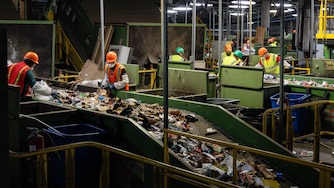The flickering lights and billowing black smoke seen on the cargo ship that crashed into the Francis Scott Key bridge on Tuesday morning represent multiple levels of failure, maritime transportation experts say.
The Dali, a Singapore-based cargo ship, crashed into a column of the bridge around 1:30 a.m., causing the 1.6-mile-long overpass to collapse. The ship was just half an hour into a planned 27-day voyage.
Captain Jeffrey Spillane, the dean of the School of Maritime Education and Training at State University of New York System Maritime, called Tuesday’s crash a one-in-a-million incident “so catastrophic that it will surely cause changes in the industry.”
The smoke and flickering lights may mean that the 1,000-foot ship lost electricity, which can lead to a loss of propulsion and steering, he said, calling such a loss highly unusual.
“Vessels are not designed to give off black smoke. That’s a huge, glaring problem that tells me there was a lot more going on,” Spillane said. “There should have been multiple redundancies going on to prevent that.”
Captain Joseph Ahlstrom serves on the Board of Commissioners of Pilots of the State of New York, which regulates the bays and ports in the New York area. He also teaches safety management classes at SUNY Maritime. He believes the black cloud that emerged from the stack of the ship means the Dali either “lost power or steering, or both.”
If a vessel emits smoke as dark as the cloud seen on Tuesday, ships receive an environmental fine, he said. “Black smoke means they may have been attempting to drastically change speeds, signaling a problem,” he said.
Spillane and Ahlstrom said a vessel will not dramatically lose control unless multiple contingencies fail or are neglected, and stressed that it is difficult to say without speculating what mechanical or operational failures may have contributed to the crash.
Synergy Marine Group, the Singapore-based technical manager for Dali, said in a statement it’s unclear what caused the collision and that owners and managers are cooperating with government agencies. The company said all 22 crew members on board, including two pilots, have been accounted for with no reported injuries.
Dali is owned by Grace Ocean Investment of Singapore and flies under the country’s flag. Maersk, the Denmark-based shipping giant, had chartered the vessel.
Because Dali is an international vessel, its crew must follow a safety management system set by international law, Spillane said. The policy dictates everything from how many people must be staffed at different points of the ship to the different vessel parts that must be inspected and cleared as operational before a voyage. If anything significant is not working, the vessel captain must disclose the issues to both local port managers and the U.S. Coast Guard.
Ahlstrom said the checklist includes the steering and engine systems. “They make sure the vessel is sound to get underway. If it’s not working well, they’re not supposed to get on their way,” he said.
Spillane added that local pilots are assigned to international ships to assist the vessel captains with navigating local geography. “These guys are all experts, and they’re qualified for the port they’re going in and out of,” he said.
The vessel was built by Hyundai in 2015. Of the 27 inspections for Dali logged in an online database maintained by Electronic Quality Shipping Information System, two noted deficiencies. In 2016, one report logged damage on the hull’s ship. That year, Dali hit a stone wall while unmooring at the Port of Antwerp. The vessel reportedly sustained minor damages and was detained for repairs. In June, another inspection found problems with “propulsion and auxiliary machinery.”
The vessel was last inspected in September by the U.S. Coast Guard, which found no deficiencies, according to the database.

When a vessel is departing a port, Ahlstrom said, the captain will work with local pilots to write a passage plan. That plan must include the proposed exit route, as well as contingencies in case the vessel departs from the planned route.
There are two main contingencies for when a vessel loses steering and power abilities, Ahlstrom said. A chief mate or deck officer on the bow of the boat will release the anchor to stop the ship. And if a tugboat is stationed next to the vessel, “you can contact the tug and have it push you away from an obstacle or get guided away.”
“If not, you’re at the mercy of the course you were on,” Ahlstrom said.
Imagine your car losing its power, he added. “You can’t accelerate, but you can put on your brakes and glide to a halt. A ship doesn’t have that luxury. It’s like if your car’s brakes went out, too.”
Ahlstrom said he’s changed lesson plans for this week’s maritime safety management classes and now plans to emphasize the importance of contingencies for automated steering. “I’ll reinforce the idea that you can’t be completely dependent on automation,” he said.
He will also tell students that contingency plans must factor in the time it takes to react to failures, as well as the speed a vessel plans to reach as it is departing a port.
“Under a worst-case scenario, are you traveling at a speed that would damage the vessel or something it crashed into?” he said.




Comments
Welcome to The Banner's subscriber-only commenting community. Please review our community guidelines.